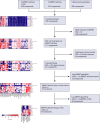Drug sensitivity and resistance testing identifies PLK1 inhibitors and gemcitabine as potent drugs for malignant peripheral nerve sheath tumors
- PMID: 28556483
- PMCID: PMC5579334
- DOI: 10.1002/1878-0261.12086
Drug sensitivity and resistance testing identifies PLK1 inhibitors and gemcitabine as potent drugs for malignant peripheral nerve sheath tumors
Abstract
Patients with malignant peripheral nerve sheath tumor (MPNST), a rare soft tissue cancer associated with loss of the tumor suppressor neurofibromin (NF1), have poor prognosis and typically respond poorly to adjuvant therapy. We evaluated the effect of 299 clinical and investigational compounds on seven MPNST cell lines, two primary cultures of human Schwann cells, and five normal bone marrow aspirates, to identify potent drugs for MPNST treatment with few side effects. Top hits included Polo-like kinase 1 (PLK1) inhibitors (volasertib and BI2536) and the fluoronucleoside gemcitabine, which were validated in orthogonal assays measuring viability, cytotoxicity, and apoptosis. DNA copy number, gene expression, and protein expression were determined for the cell lines to assess pharmacogenomic relationships. MPNST cells were more sensitive to BI2536 and gemcitabine compared to a reference set of 94 cancer cell lines. PLK1, RRM1, and RRM2 mRNA levels were increased in MPNST compared to benign neurofibroma tissue, and the protein level of PLK1 was increased in the MPNST cell lines compared to normal Schwann cells, indicating an increased dependence on these drug targets in malignant cells. Furthermore, we observed an association between increased mRNA expression of PLK1, RRM1, and RRM2 in patient samples and worse disease outcome, suggesting a selective benefit from inhibition of these genes in the most aggressive tumors.
Keywords: MPNST; Schwann cell; drug screen; pharmacology.
© 2017 The Authors. Published by FEBS Press and John Wiley & Sons Ltd.
Figures




Similar articles
-
MLN0905 effectively kills gemcitabine-resistant pancreatic cancer cells by targeting PLK1.Eur J Med Res. 2025 Jul 3;30(1):567. doi: 10.1186/s40001-025-02825-8. Eur J Med Res. 2025. PMID: 40611188 Free PMC article.
-
Polo-like kinase 1 inhibition as a new therapeutic modality in therapy of cholangiocarcinoma.Anticancer Res. 2011 Oct;31(10):3289-99. Anticancer Res. 2011. PMID: 21965739
-
Dual mTORC1/2 inhibition induces anti-proliferative effect in NF1-associated plexiform neurofibroma and malignant peripheral nerve sheath tumor cells.Oncotarget. 2016 Jun 14;7(24):35753-35767. doi: 10.18632/oncotarget.7099. Oncotarget. 2016. PMID: 26840085 Free PMC article.
-
PLK1 Inhibition: Prospective Role for the Treatment of Pediatric Tumors.Curr Drug Targets. 2016;17(14):1661-1672. doi: 10.2174/1389450116666150825120235. Curr Drug Targets. 2016. PMID: 26302797 Review.
-
Plk1 Inhibitors in Cancer Therapy: From Laboratory to Clinics.Mol Cancer Ther. 2016 Jul;15(7):1427-35. doi: 10.1158/1535-7163.MCT-15-0897. Epub 2016 Jun 21. Mol Cancer Ther. 2016. PMID: 27330107 Free PMC article. Review.
Cited by
-
Systemic Treatment for Advanced and Metastatic Malignant Peripheral Nerve Sheath Tumors-A Sarcoma Reference Center Experience.J Clin Med. 2020 Sep 29;9(10):3157. doi: 10.3390/jcm9103157. J Clin Med. 2020. PMID: 33003503 Free PMC article.
-
High-throughput ex vivo drug testing identifies potential drugs and drug combinations for NRAS-positive malignant melanoma.Transl Oncol. 2022 Jan;15(1):101290. doi: 10.1016/j.tranon.2021.101290. Epub 2021 Nov 24. Transl Oncol. 2022. PMID: 34837846 Free PMC article.
-
HN1L/AP-2γ/PLK1 signaling drives tumor progression and chemotherapy resistance in esophageal squamous cell carcinoma.Cell Death Dis. 2022 Dec 7;13(12):1026. doi: 10.1038/s41419-022-05478-1. Cell Death Dis. 2022. PMID: 36476988 Free PMC article.
-
Comprehensive analysis reveals a metabolic ten-gene signature in hepatocellular carcinoma.PeerJ. 2020 May 26;8:e9201. doi: 10.7717/peerj.9201. eCollection 2020. PeerJ. 2020. PMID: 32518728 Free PMC article.
-
Combined Inhibition of SHP2 and MEK Is Effective in Models of NF1-Deficient Malignant Peripheral Nerve Sheath Tumors.Cancer Res. 2020 Dec 1;80(23):5367-5379. doi: 10.1158/0008-5472.CAN-20-1365. Epub 2020 Oct 8. Cancer Res. 2020. PMID: 33032988 Free PMC article.
References
-
- Abbou S, Lanvers‐Kaminsky C, Daudigeos‐Dubus E, LE Dret L, Laplace‐Builhe C, Molenaar J, Vassal G, Geoerger B, within the IB Preclinical Evaluation C (2016) Polo‐like kinase inhibitor volasertib exhibits antitumor activity and synergy with vincristine in pediatric malignancies. Anticancer Res 36, 599–609. - PubMed
-
- Ågesen TH, Flørenes VA, Molenaar WM, Lind GE, Berner JM, Plaat BE, Komdeur R, Myklebost O, van den Berg E and Lothe RA (2005) Expression patterns of cell cycle components in sporadic and neurofibromatosis type 1‐related malignant peripheral nerve sheath tumors. J Neuropathol Exp Neurol 64, 74–81. - PubMed
-
- Albritton KH, Rankin C, Coffin CM, Ratner N, Budd GT, Schuetze SM, Randall RL, Declue JE and Borden EC (2006) Phase II study of erlotinib in metastatic or unresectable malignant peripheral nerve sheath tumors (MPNST). J Clin Oncol 24, S9518.
MeSH terms
Substances
LinkOut - more resources
Full Text Sources
Other Literature Sources
Medical
Research Materials
Miscellaneous

